
What is a neurodevelopmental disorder?
Neurodevelopmental disorders (NDs) are behavioural and cognitive disorders that arise during the development period. They involve significant difficulties in the acquisition and execution of specific intellectual, motor, language, or social functions.[1] These disorders, which affect various aspects of development, manifest themselves to varying degrees, ranging from specific limitations to more general alterations.
Neurodevelopment refers to the development of the brain and the neural connections to ensure its proper functioning. These disorders have significant impacts on many aspects of life, such as learning, emotions, memory, attention and socialization.
NDs result from genetic and biological predispositions, but also from external factors (socio-cultural, emotional and environmental). They usually begin in early childhood or even during pregnancy and persist into adulthood. Disorders can also coexist (comorbidity), meaning that one person may have multiple disorders at the same time. In addition, health or mental health problems such as sleep disorders, digestive problems, anxiety or depression are frequently associated with NDs. These disorders, often diagnosed in childhood, can still be identified later in life. A comprehensive approach is therefore essential to consider all dimensions of NDs and their interaction with other health issues.
Main neurodevelopmental disorders according to the DMS-5
The Diagnostic and Statistical Manual of Mental Disorders, 5th Edition (DMS-5) is a global reference used to diagnose and classify mental disorders. It provides detailed diagnostic criteria that are essential for mental health professionals.
The list below shows the main NDs and their characteristics. However, it is crucial to remember that each individual is unique, and the combination and intensity of symptoms vary considerably from person to person.
Overview of the situation
Since access to a diagnosis is sometimes difficult, it is hard to accurately assess the percentage of the population with a neurodevelopmental disorder (ND). It is estimated that 15 to 20% of the population has a language-related learning disability, 1.5% autism spectrum disorder (ASD) and 6 to 17% attention deficit/ hyperactivity disorder (ADHD). Due to the frequency of comorbidities and under-diagnosis, particularly among women, a realistic estimate of the population with ND sits at 15 to 20%[5].
Although the diagnosis is usually made during childhood, some people are not diagnosed until they are adults. In Québec, many programs and initiatives have been developed in recent years to promote the optimal development of children and improve services for those experiencing difficulties. Despite these advances, services related to neurodevelopmental disorders remain insufficient, particularly in terms of accessibility, efficiency, coordination and continuity of services.
Neuroinclusion: An approach for all
The term neuroinclusion is increasingly used to refer to the inclusion of people who are neurodivergent, neurotypical and/or have neurodegenerative disease.
- Neurodivergent: refers to persons whose neurological functioning differs from the norm, with or without a formal diagnosis.
- Neurotypical: describes individuals whose neurological functioning is considered standard and who do not have a specific neurological condition.
- Neurodegenerative disease: refers to a medical condition marked by progressive deterioration of neurons and the nervous system.
Neuroinclusion aims to create an environment where every individual, regardless of their neurological condition, feels respected, supported and encouraged to thrive in all aspects of their life: educational, social, medical and professional.[6]
In an employment context, for example, this may include:
- Physical adjustment of the premises (ergonomic arrangements).
- The addition of work accessories or supporting software.
- Tailoring tasks to reflect employees’ specific strengths and challenges.
Promoting neuroinclusion helps build open, safe and accessible environments for all.
Standards and obligations
In Canada, there are no accessibility standards specifically focused on neurodevelopmental disorders (NDs). However, certain accessibility standards and obligations can benefit people living with these conditions.
It is important to note that these standards and regulations are intended to promote the inclusion and participation of all persons with disabilities, including those with neurodevelopmental disorders.
Good practices
There are many ways to promote neuroinclusion in schools, workplaces and daily interactions. However, it is necessary to understand that automatically applying a set of recommendations, regardless of the context and its implications, can lead to misunderstanding or frustration on both sides. The needs and preferences in terms of environment, communication and attitude vary considerably from one neurodivergent person to another. In addition, these preferences may change over time or depending on the situation. For example, while a recommendation may be appropriate for a person in a given context, it may be inadequate or even harmful in other circumstances.
That said, it should be noted that, in most cases, adjustments made to accommodate persons with neurodevelopmental disorders (NDs) benefit everyone. A predictable environment, offering choices (social or sensory) and characterized by spatial and organizational coherence, constitutes a neuroinclusive environment that meets the needs of all.
Finally, it is essential to remember that each person has their own unique characteristics and needs. Offering a diversity of choice is often more relevant than imposing a uniform solution.
These good practices create respectful and inclusive environments where everyone has the opportunity to thrive and reach their full potential.
Available resources
Training
- Autoformation : How to better welcome persons with disabilities – autism spectrum disorder], Government of Québec
- Better understanding autism, Centre d’expertise en autisme SACCADE.
- Training on neurodevelopmental disorders, Centre de formation CENOPe.
- Training on ADHD, Fondation Philippe Laprise.
- Training on intellectual development disorders, Québec Intellectual Disability Society.
Subsidies
In Québec, several programs, action plans and measures have been put in place to support the optimal development of children and improve the service offering for those experiencing difficulties or developmental delays. This list provides a variety of tools to support inclusion and meet the needs of persons with disabilities.
Fondations
- Fondation Philippe Laprise: Awareness and engagement initiatives to improve the future of those affected by ADHD.
- Fondation Autiste et majeur: Support for social integration and quality of life for adults with autism.
- Fondation Véro & Louis: Creation of permanent and adapted living environments for people with autism aged 21 and over.
Documents
- Info-troubles : Développemental, Association québécoise des neuropsychologues.
- Care pathways leading to the diagnostic assessment of neurodevelopmental disorders in children, Institut national d’excellence en santé et en services sociaux.
- Understanding neurodiversity, aiming for neuroinclusion: Vocabulary and reflective tools, Collectif autisme de l’UQAM.
- Facilitating Neuromixed Communication in the Workplace, Crispesh.
- Inclusive Design for Neurodiversity: Creating Harmonious Spaces for a Diverse Future, Modulyss (Belgium).
- Designing for Neurodiversity and Inclusion, Work Design Magazine.
Websites
Fact sheet prepared by Idéaux,inclusive and universal accessibility design consulting firm, with the collaboration of Irini Blais, Neuro-inclusive Accommodations Advisor.
- WHO definition
- Autism: Overview, Canada.ca
- Association des médecins psychiatres du Québec
- Towards better integration of care and services for persons with disabilities, Ministère de la Santé et des Services sociaux
- Neurodiversity at work: a biopsychosocial model and the impact on working adults, PMC
- Neurodiversity website





